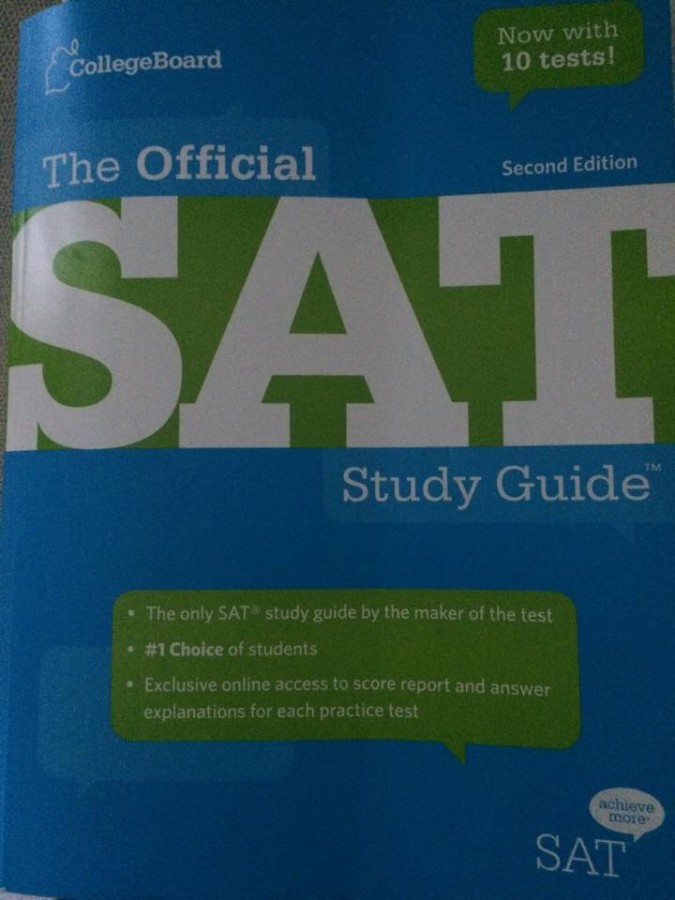College Board reinvents the SAT
Photo Credit: Zach McCollum
The Official SAT Study Guide
September 17, 2015
The College Board is in the process of changing the interface and design of the SAT for the March 5 test date.
Standardized testing is crucial to students’ application to college, and is known to enhance the test taking ability. With the ACT gaining popularity, the College Board has decided to reinvent the SAT to create more similarities with its counterpart like an optional essay, more allotted time per section, and a no guessing penalty.
What’s Changed
There are many changes coming to the way the SAT will be taken and scored. There will no longer be a penalty for guessing, which will encourage students to not leave any questions blank. This scoring method is already used on the ACT.
“One of our biggest goals in changing the SAT is to make sure it’s relevant to your future success,” says the College Board via https://collegereadiness.collegeboard.org/.
The test will now measure what students learn in high school and what is needed to succeed in college, rather than simply measuring test taking skills. This is another change that is parallel to the purpose of the ACT.
“The new test will be more focused on the skills and knowledge at the heart of education,” claims the College Board.
Each of the four tests has been revised to suit the new SAT format. The Reading Test has faced a number of significant changes. One of the said changes will be the addition of graphics such as tables, graphs, and charts, which is very similar to the Science Test of the ACT. These graphics will be used in correlation with the passage.
The Reading Test will also include a new analysis in history, social studies, and science. Questions regarding these three subjects will include examining hypotheses, interpreting data, and considering the implications of certain times in history.
Changes on the Math Test are much less significant than those of the Reading Test. There will now be a “no calculator” portion of this test, and some of parts of it will contain multiple questions about a single problem.
“It’s like a reading comprehension test,” said Klaudia Rizzo, a SAT and ACT tutor “It will be very difficult for kids to adjust to it.”
The Writing Test has also faced a few changes, with the name being changed to “Writing and Language Test”, as well as becoming part of something called the “Evidence-Based Reading and Writing Section,” which will also include the Reading Test. The Writing and Language Test, like the Reading Test, will also include the addition of graphics.
Out of all the sections, the most changes are coming to the Essay section of the SAT. For the essay, students will now be asked to read a passage and analyze the text. Students will also be asked to try to persuade an audience by building up an argument by using the passage they are provided.
The Essay section is following the trend that all the sections do, in that it will be much more like its competitor the ACT. The Essay will now be optional and 50 minutes long, which is 25 minutes longer than the old version of the test. Students will not be asked to provide personal examples, as they are now taking a formal stance on the given topic.
What’s Staying the Same
Although the SAT is making an alarming number of changes to the format and style of the test, there are still a few aspects that are remaining the same. Colleges will not withhold the acceptance of the new SAT, and will still accept any form of the test. The main demographic per season will also not change. This means that juniors will still be taking the test in the fall and juniors will still be taking it in the spring.
Pros and Cons
Some pros of the new SAT are less vocabulary and no sentence completions. The vocabulary that will be featured on the test will be more familiar to students. There will also be only four answer choices instead of 5 and students have no penalty for wrong answers.
Even with some of the positive changes, there are some that students may not necessarily enjoy. For example, many of the new SAT questions will include more steps to get the final answer. Although there will be no sentence completions with hard vocabulary, reading passages will have complex vocabulary and sentence structure. Students will have to use more reasoning and critical vocabulary. Finally, the new test will have fewer sections but each section will be much longer.
There are also changes to the SAT that could be either a pro or con for students. One of the biggest changes in the new SAT is the scoring. Before 2005, the SAT was scored up to 1600. From 2005 to 2015 College Board moved the total score up to 2400. With the new SAT scoring will revert back to the old scoring. In addition to the lower scoring range, the new SAT has made the essay optional and provided more time for students to take the test. Finally the new SAT now uses paper and pencil and a computer based option.
The class of 2017 will be the first class of students allowed to take the new SAT. They also have the choice of taking the old SAT or even the ACT.





